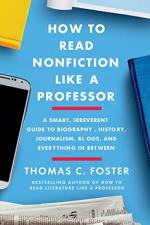
|
| Name: _________________________ | Period: ___________________ |
This quiz consists of 5 multiple choice and 5 short answer questions through Section 5: Chapter 16, "Social (Media) Disease" through "Conclusion".
Multiple Choice Questions
1. In Chapter 5, "It May Just Be Me, But..." what does Foster say is true about quotes attributed to anonymous sources?
(a) There is never a good reason to use a quote from an anonymous source.
(b) These quotes are often made up.
(c) There are likely to be good reasons for the source to stay anonymous.
(d) These quotes are often just the reporter's interpretation of a source's meaning.
2. In Chapter 2, "The Ecology of the Nonfiction Biosphere," where does Foster say editorial content can usually be found in the newspaper?
(a) At the very end of the last section.
(b) The last page or pages of the front section.
(c) In its own section.
(d) Throughout most sections.
3. How, in Chapter 16, "Social (Media) Disease," does Foster define "bot"?
(a) Software that performs a simple task.
(b) A troll or hacker working for a government or corporation.
(c) A small piece of data housed on a user's computer by a website.
(d) An automated follower on social media.
4. In Chapter 9, "Living the News," how does Foster apply the idea of "free indirect speech" to New Journalism?
(a) He uses it to contrast New Journalism with fiction.
(b) He uses it to compare New Journalism with immersive journalism.
(c) He uses it to explain how Thompson narrates his own thoughts.
(d) He uses it to label Wolfe's attempt to recreate the inner lives of his subjects.
5. In Chapter 9, "Living the News," which authors does Foster point out as not engaged in New Journalism?
(a) Mailer and Didion.
(b) Woodward and Bernstein.
(c) Capote and Agee.
(d) Breslin and Talese.
Short Answer Questions
1. In Chapter 15, "Reading Internet Sources," what does Foster call the "fatal flaw" of the internet?
2. According to Chapter 4, "The Parts You Don't Read," what are the sidebar discussions found in the book's back matter called?
3. According to "The Building Blocks of Arguments," what are the "grounds" of a argument?
4. In Chapter 9, "Living the News," what does Foster say is the main difference between New Journalism and immersive journalism?
5. In Chapter 13, "On the Stump," Foster refers to White House staff as "denizens" (190). What is the best definition of this word in this context?
|
This section contains 430 words (approx. 2 pages at 300 words per page) |

|




